Related Research Articles
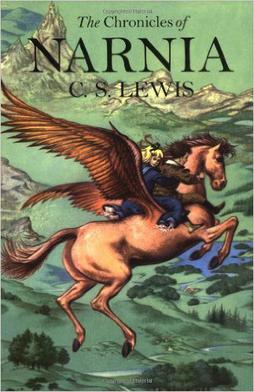
The Chronicles of Narnia is a series of seven portal fantasy novels by British author C. S. Lewis. Illustrated by Pauline Baynes and originally published between 1950 and 1956, The Chronicles of Narnia has been adapted for radio, television, the stage, film, and video games. The series is set in the fictional realm of Narnia, a fantasy world of magic, mythical beasts and talking animals. It narrates the adventures of various children who play central roles in the unfolding history of the Narnian world. Except in The Horse and His Boy, the protagonists are all children from the real world who are magically transported to Narnia, where they are sometimes called upon by the lion Aslan to protect Narnia from evil. The books span the entire history of Narnia, from its creation in The Magician's Nephew to its eventual destruction in The Last Battle.
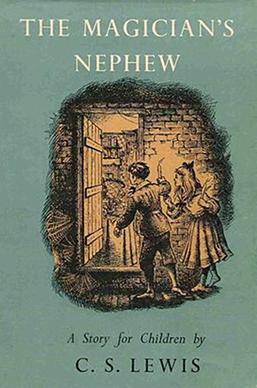
The Magician's Nephew is a portal fantasy children's novel by C. S. Lewis, published in 1955 by The Bodley Head. It is the sixth published of seven novels in The Chronicles of Narnia (1950–1956). In recent editions, which sequence the books according to Narnia history, it is volume one of the series. Like the others, it was illustrated by Pauline Baynes whose work has been retained in many later editions. The Bodley Head was a new publisher for The Chronicles, a change from Geoffrey Bles who had published the previous five novels.
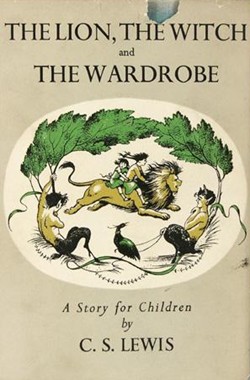
The Lion, the Witch and the Wardrobe is a portal fantasy novel for children by C. S. Lewis, published by Geoffrey Bles in 1950. It is the first published and best known of seven novels in The Chronicles of Narnia (1950–1956). Among all the author's books, it is also the most widely held in libraries. It was the first of The Chronicles of Narnia to be written and published, but is marked as volume two in recent editions that are sequenced according the stories' internal chronology. Like the other Chronicles, it was illustrated by Pauline Baynes, and her work has been retained in many later editions.
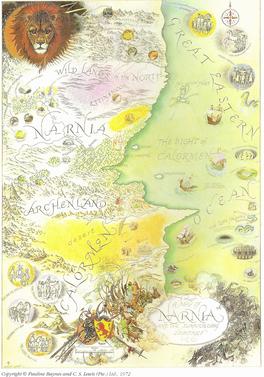
Narnia is a fantasy world created by C. S. Lewis as the primary location for his series of seven fantasy novels for children, The Chronicles of Narnia. The world is named after the country of Narnia, where much of the Chronicles takes place.
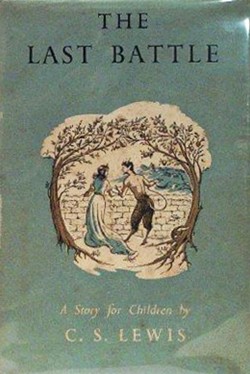
The Last Battle is a portal fantasy novel for children by C. S. Lewis, published by The Bodley Head in 1956. It was the seventh and final novel in The Chronicles of Narnia (1950–1956). Like the other novels in the series, it was illustrated by Pauline Baynes and her work has been retained in many later editions.

The Silver Chair is a children's portal fantasy novel by C. S. Lewis, published by Geoffrey Bles in 1953. It was the fourth published of seven novels in The Chronicles of Narnia (1950–1956); it is volume six in recent editions, which are sequenced according to Narnian history. Like the others, it was illustrated by Pauline Baynes and her work has been retained in many later editions.
Charn is a fictional city appearing in the 1955 book The Magician's Nephew, the sixth book published in C. S. Lewis's Chronicles of Narnia, written as a prequel to The Lion, the Witch, and the Wardrobe. Charn, and the world of which it is the capital city, are the birthplace of Jadis, also known as the White Witch, who later seizes control of Narnia.
In C. S. Lewis's Chronicles of Narnia series of novels, Calormen is a large country to the southeast of Narnia. Lewis probably derived its name from the Latin calor, meaning "heat". When using the name as an adjective or an ethnonym, Lewis spelled the name with an 'e' at the end: a Calormene soldier; "The Calormenes have dark faces and long beards."
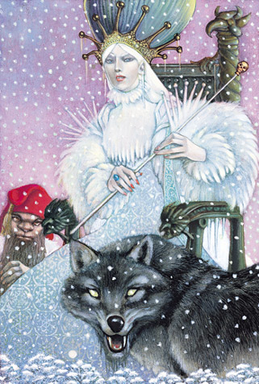
Jadis is a fictional character and the main antagonist of The Lion, the Witch and the Wardrobe (1950) and The Magician's Nephew (1955) in C. S. Lewis's series, The Chronicles of Narnia. She is commonly referred to as the White Witch in The Lion, the Witch and the Wardrobe, as she is the Witch who froze Narnia in the Hundred Years Winter.
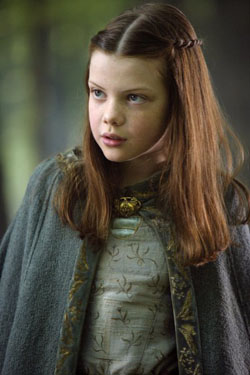
Lucy Pevensie is a fictional character in C. S. Lewis's The Chronicles of Narnia series. She is the youngest of the four Pevensie children, and the first to find the Wardrobe entrance to Narnia in The Lion, the Witch and the Wardrobe. Of all the Pevensie children, Lucy is the closest to Aslan. Also, of all the humans who have visited Narnia, Lucy is perhaps the one that believes in Narnia the most. She is ultimately crowned Queen Lucy the Valiant, co-ruler of Narnia along with her two brothers and her sister. Lucy is the central character of the four siblings in the novels. Lucy is a principal character in three of the seven books, and a minor character in two others.

Peter Pevensie is a fictional character in C. S. Lewis's The Chronicles of Narnia book series. Peter appears in three of the seven books; as a child and a principal character in The Lion, the Witch and the Wardrobe and Prince Caspian, and as an adult in The Last Battle. He is mentioned in The Horse and His Boy, in which he is away on the northern frontier fighting giants, and in The Voyage of the Dawn Treader, in which he is studying under the tutelage of Professor Kirke.

Jill Pole is a major character from C. S. Lewis' Chronicles of Narnia series. She appears in The Silver Chair and The Last Battle.
Polly Plummer is a major fictional character from C. S. Lewis's fantasy series The Chronicles of Narnia. She appears in two of the seven books: The Magician's Nephew and The Last Battle.
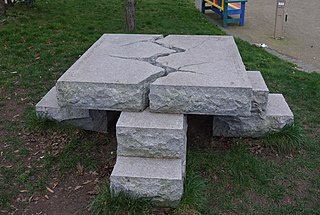
In C. S. Lewis's fantasy novel series the Chronicles of Narnia, the hill of the Stone Table, or Aslan's How, is a high mound or cairn, located south of the Great River in Narnia next to the Great Woods. The How was built over the hill of the Stone Table. The word how derives from the Old Norse haugr, meaning hill or mound. In parts of England, it is a synonym for barrow.
The Chronicles of Narnia is a fantasy film series and media franchise based on The Chronicles of Narnia, a series of novels by C. S. Lewis. The series revolves around the adventures of children in the world of Narnia, guided by Aslan, a wise and powerful lion that can speak and is the true king of Narnia. The children heavily featured in the films are the Pevensie siblings, and a prominent antagonist is the White Witch. The franchise also includes short films, digital series, and video games.

Aslan is a major character in C. S. Lewis's The Chronicles of Narnia series. Unlike any other character in the Narnian series, Aslan appears in all seven chronicles. Aslan is depicted as a talking lion and is described as the King of Beasts, the son of the Emperor-Over-the-Sea, and the King above all High Kings in Narnia.
The Chronicles of Narnia is a series of seven fantasy novels for children written by C. S. Lewis. It is considered a classic of children's literature and is the author's best-known work, having sold over 100 million copies in 47 languages. The series borrows characters and ideas from Classical, Norse, Irish, Arthurian, Islamic, Jewish and Christian mythology. Of all the mythologies taken into consideration, the Christian one is the most fundamental for the Narnia series, due to the themes covered.
The following outline is provided as an overview of and topical guide to Narnia:
Magical creatures are an important aspect of the fictional world of Narnia contained within The Chronicles of Narnia book series and connected media originally created by C. S. Lewis. Throughout the seven books of the series, the protagonists encounter a variety of these creatures as they travel throughout Narnia and the surrounding lands and seas, including Archenland, Calormen, and the Great Eastern Ocean.
References
- ↑ Lewis, Clive Staples (1970). The Magician's Nephew . New York: Macmillan Publishing Company. pp. 41–65. ISBN 0-02-044230-0.
- ↑ Mony, Neetha (2003). "True Independent Women: A Close Comparison Between C. S. Lewis's Jadis, the White Witch, and J. R. R. Tolkien's Galadriel, The Lady of the Golden Wood" (PDF). In Diana Pavlac Glyer (ed.). Tollers and Jack: A Comparative Look at the Lives and Works of J.R. R. Tolkien and C. S. Lewis. p. 8.
By saying the Deplorable Word, a word that Lewis does not reveal.
- ↑ Ford, Paul F. (2005). Companion to Narnia, Revised Edition: A Complete Guide to the Magical World of C.S. Lewis's THE CHRONICLES OF NARNIA. New York: Zondervan. p. 138. ISBN 0060791276.
- ↑ Lewis, Clive Staples (1970). The Magician's Nephew . New York: Macmillan Publishing Company. p. 178. ISBN 0-02-044230-0.
- ↑ Walls, Kathryn (2009). "When Curiosity Gets the Better of Us: The Atomic Bomb in The Magician's Nephew". Journal of the Fantastic in the Arts. 20 (3): 334.
In what follows, I want to suggest that The Magician's Nephew is very much the product of Lewis's own anxiety about nuclear weapons. [...] Aslan... effectively aligns the "Deplorable Word" (with which Jadis had destroyed the city of Charn) with the scientific knowledge behind the bomb. ...
- ↑ Hinten, Marvin D. (Spring 2003). "The Founding of Narnia: Allusions in 'The Magician's Nephew'". The Lamp-Post of the Southern California C.S. Lewis Society. 27 (1): 19. JSTOR 45349888.
In the final chapter, Aslan tells Polly and Digory that a "Deplorable Word" equivalent may soon appear on our planet, an obvious reference to the atomic bomb...